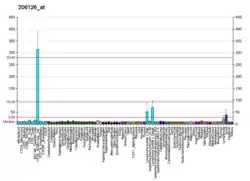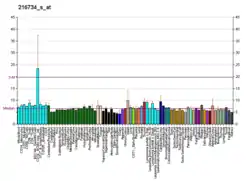CXCR5
C-X-C chemokine receptor type 5 (CXC-R5) also known as CD185 (cluster of differentiation 185) or Burkitt lymphoma receptor 1 (BLR1) is a G protein-coupled seven transmembrane receptor for chemokine CXCL13 (also known as BLC) and belongs to the CXC chemokine receptor family. It enables T cells to migrate to lymph node and the B cell zones. In humans, the CXC-R5 protein is encoded by the CXCR5 gene.[5]
Tissue distribution and function
The BLR1 / CXCR5 gene is specifically expressed in Burkitt's lymphoma and lymphatic tissues, such as follicles in lymph nodes as well as in spleen. The gene plays an essential role in B cell migration.[6] Through CXCL13 secretions B cells are able to locate the lymph node.[6]
Additionally, some recent studies have suggested that CXCL13, through CXCR5, is capable of recruiting hematopoietic precursor cells (CD3− CD4+) which would cause the development of lymph nodes and Peyer's Patches.[7][8]
Other studies highlight the role of CXCR5 in T cells, as they are unable to access B cell follicles without CXCR5 expression.[9][10] This is a key step in the production of high affinity antibodies as B cells and T cells need to interact in order to activate the Ig class switch.[9]
CXCR5 has been shown to be expressed on both CD4[11] and CD8[12] T cells, though it is often regarded as the defining marker for T Follicular Helper (Tfh) cells.[13]
Role in cancer development
Recently, it was shown that CXCR5 overexpression in breast cancer patients highly correlates with lymph node metastases,[14] and elevated CXCR5 expression may contribute to abnormal cell survival and migration in breast tumors that lack functional p53 protein.[15] Minor allele of SNP rs630923, located in the area of CXCR5 gene promoter and associated with the risk of multiple sclerosis, is responsible for appearance of MEF2C-binding site resulted in reduced CXCR5 gene promoter activity in B-cells during activation, that could lead to decreased autoimmune response [16]
While chemokines and chemokine receptors have been thought to be involved in cancer development and maintenance, recently CXCR5 has come under investigation for its role in metastatic progression of prostate cancer. A recent study has indicated that prostate cancer tissue as well as cell lines express higher non-basal levels of CXCR5.[17] Furthermore, the study found a correlation between the level of CXCR5 and Gleason score. CXCR5 location was additionally considered and higher Gleason scores correlated with nuclear CXCR5 while cytoplasmic and membrane CXCR5 correlated with benign and early prostate cancers.[17]
References
- GRCh38: Ensembl release 89: ENSG00000160683 - Ensembl, May 2017
- GRCm38: Ensembl release 89: ENSMUSG00000047880 - Ensembl, May 2017
- "Human PubMed Reference:". National Center for Biotechnology Information, U.S. National Library of Medicine.
- "Mouse PubMed Reference:". National Center for Biotechnology Information, U.S. National Library of Medicine.
- Dobner T, Wolf I, Emrich T, Lipp M (November 1992). "Differentiation-specific expression of a novel G protein-coupled receptor from Burkitt's lymphoma". European Journal of Immunology. 22 (11): 2795–9. doi:10.1002/eji.1830221107. PMID 1425907. S2CID 35096818.
- Förster R, Mattis AE, Kremmer E, Wolf E, Brem G, Lipp M (December 1996). "A putative chemokine receptor, BLR1, directs B cell migration to defined lymphoid organs and specific anatomic compartments of the spleen". Cell. 87 (6): 1037–47. doi:10.1016/S0092-8674(00)81798-5. PMID 8978608. S2CID 17558174.
- Honda, Kenya; Nakano, Hiroyasu; Yoshida, Hisahiro; Nishikawa, Satomi; Rennert, Paul; Ikuta, Koichi; Tamechika, Masakatsu; Yamaguchi, Kazuhito; Fukumoto, Tetsuo (2001-03-05). "Molecular Basis for Hematopoietic/Mesenchymal Interaction during Initiation of Peyer's Patch Organogenesis". The Journal of Experimental Medicine. 193 (5): 621–630. doi:10.1084/jem.193.5.621. ISSN 0022-1007. PMC 2193398. PMID 11238592.
- Finke, D; Acha-Orbea, H; Mattis, A; Lipp, M; Kraehenbuhl, J.P (September 2002). "CD4+CD3− Cells Induce Peyer's Patch Development". Immunity. 17 (3): 363–373. doi:10.1016/S1074-7613(02)00395-3. PMID 12354388.
- Junt, Tobias; Fink, Katja; Förster, Reinhold; Senn, Beatrice; Lipp, Martin; Muramatsu, Masamichi; Zinkernagel, Rolf M.; Ludewig, Burkhard; Hengartner, Hans (2005-12-01). "CXCR5-dependent seeding of follicular niches by B and Th cells augments antiviral B cell responses". Journal of Immunology. 175 (11): 7109–7116. doi:10.4049/jimmunol.175.11.7109. ISSN 0022-1767. PMID 16301613.
- Hardtke, S. (2005-09-15). "Balanced expression of CXCR5 and CCR7 on follicular T helper cells determines their transient positioning to lymph node follicles and is essential for efficient B-cell help". Blood. 106 (6): 1924–1931. doi:10.1182/blood-2004-11-4494. ISSN 0006-4971. PMID 15899919.
- Chevalier N, Jarrossay D, Ho E, Avery DT, Ma CS, Yu D, Sallusto F, Tangye SG, Mackay CR (May 2011). "CXCR5 expressing human central memory CD4 T cells and their relevance for humoral immune responses". Journal of Immunology. 186 (10): 5556–68. doi:10.4049/jimmunol.1002828. PMID 21471443.
- He R, Hou S, Liu C, Zhang A, Bai Q, Han M, Yang Y, Wei G, Shen T, Yang X, Xu L, Chen X, Hao Y, Wang P, Zhu C, Ou J, Liang H, Ni T, Zhang X, Zhou X, Deng K, Chen Y, Luo Y, Xu J, Qi H, Wu Y, Ye L (August 2016). "Follicular CXCR5- expressing CD8(+) T cells curtail chronic viral infection". Nature. 537 (7620): 412–428. Bibcode:2016Natur.537..412H. doi:10.1038/nature19317. PMID 27501245. S2CID 4469688.
- Moser B (2015). "CXCR5, the Defining Marker for Follicular B Helper T (TFH) Cells". Frontiers in Immunology. 6: 296. doi:10.3389/fimmu.2015.00296. PMC 4459225. PMID 26106395.
- Biswas S, Sengupta S, Roy Chowdhury S, Jana S, Mandal G, Mandal PK, Saha N, Malhotra V, Gupta A, Kuprash DV, Bhattacharyya A (January 2014). "CXCL13-CXCR5 co-expression regulates epithelial to mesenchymal transition of breast cancer cells during lymph node metastasis". Breast Cancer Research and Treatment. 143 (2): 265–76. doi:10.1007/s10549-013-2811-8. PMID 24337540. S2CID 2937341.
- Mitkin NA, Hook CD, Schwartz AM, Biswas S, Kochetkov DV, Muratova AM, Afanasyeva MA, Kravchenko JE, Bhattacharyya A, Kuprash DV (March 2015). "p53-dependent expression of CXCR5 chemokine receptor in MCF-7 breast cancer cells". Scientific Reports. 5 (5): 9330. Bibcode:2015NatSR...5E9330M. doi:10.1038/srep09330. PMC 4365401. PMID 25786345.
- Mitkin NA, Muratova AM, Schwartz AM, Kuprash DV (Nov 2016). "The A Allele of the Single-Nucleotide Polymorphism rs630923 Creates a Binding Site for MEF2C Resulting in Reduced CXCR5 Promoter Activity in B-Cell Lymphoblastic Cell Lines". Frontiers in Immunology. 7 (515): 515. doi:10.3389/fimmu.2016.00515. PMC 5112242. PMID 27909439.
- Singh, Shailesh; Singh, Rajesh; Singh, Udai P.; Rai, Shesh N.; Novakovic, Kristian R.; Chung, Leland W.K.; Didier, Peter J.; Grizzle, William E.; Lillard, James W. (2009-11-15). "Clinical and biological significance of CXCR5 expressed by prostate cancer specimens and cell lines". International Journal of Cancer. 125 (10): 2288–2295. doi:10.1002/ijc.24574. PMC 3600527. PMID 19610059.
External links
- Human CXCR5 genome location and CXCR5 gene details page in the UCSC Genome Browser.
Further reading
- Lipp M, Müller G (2006). "Shaping up adaptive immunity: the impact of CCR7 and CXCR5 on lymphocyte trafficking". Verhandlungen der Deutschen Gesellschaft für Pathologie. 87: 90–101. PMID 16888899.
- Barella L, Loetscher M, Tobler A, Baggiolini M, Moser B (August 1995). "Sequence variation of a novel heptahelical leucocyte receptor through alternative transcript formation". The Biochemical Journal. 309 ( Pt 3) (3): 773–9. doi:10.1042/bj3090773. PMC 1135699. PMID 7639692.
- Legler DF, Loetscher M, Roos RS, Clark-Lewis I, Baggiolini M, Moser B (February 1998). "B cell-attracting chemokine 1, a human CXC chemokine expressed in lymphoid tissues, selectively attracts B lymphocytes via BLR1/CXCR5". The Journal of Experimental Medicine. 187 (4): 655–60. doi:10.1084/jem.187.4.655. PMC 2212150. PMID 9463416.
- Gunn MD, Ngo VN, Ansel KM, Ekland EH, Cyster JG, Williams LT (February 1998). "A B-cell-homing chemokine made in lymphoid follicles activates Burkitt's lymphoma receptor-1". Nature. 391 (6669): 799–803. Bibcode:1998Natur.391..799G. doi:10.1038/35876. PMID 9486651. S2CID 4373691.
- Müller G, Lipp M (September 2001). "Signal transduction by the chemokine receptor CXCR5: structural requirements for G protein activation analyzed by chimeric CXCR1/CXCR5 molecules". Biological Chemistry. 382 (9): 1387–97. doi:10.1515/BC.2001.171. PMID 11688722. S2CID 21366051.
- Schaerli P, Loetscher P, Moser B (December 2001). "Cutting edge: induction of follicular homing precedes effector Th cell development". Journal of Immunology. 167 (11): 6082–6. doi:10.4049/jimmunol.167.11.6082. PMID 11714765.
- Kim CH, Johnston B, Butcher EC (July 2002). "Trafficking machinery of NKT cells: shared and differential chemokine receptor expression among V alpha 24(+)V beta 11(+) NKT cell subsets with distinct cytokine-producing capacity". Blood. 100 (1): 11–6. doi:10.1182/blood-2001-12-0196. PMID 12070001.
- Carlsen HS, Baekkevold ES, Johansen FE, Haraldsen G, Brandtzaeg P (September 2002). "B cell attracting chemokine 1 (CXCL13) and its receptor CXCR5 are expressed in normal and aberrant gut associated lymphoid tissue". Gut. 51 (3): 364–71. doi:10.1136/gut.51.3.364. PMC 1773345. PMID 12171958.
- Battle TE, Yen A (October 2002). "Ectopic expression of CXCR5/BLR1 accelerates retinoic acid- and vitamin D(3)-induced monocytic differentiation of U937 cells". Experimental Biology and Medicine. 227 (9): 753–62. doi:10.1177/153537020222700906. PMID 12324654. S2CID 26070911.
- Lisignoli G, Toneguzzi S, Piacentini A, Cattini L, Lenti A, Tschon M, Cristino S, Grassi F, Facchini A (January 2003). "Human osteoblasts express functional CXC chemokine receptors 3 and 5: activation by their ligands, CXCL10 and CXCL13, significantly induces alkaline phosphatase and beta-N-acetylhexosaminidase release". Journal of Cellular Physiology. 194 (1): 71–9. doi:10.1002/jcp.10188. PMID 12447991. S2CID 8031523.
- Chan CC, Shen D, Hackett JJ, Buggage RR, Tuaillon N (February 2003). "Expression of chemokine receptors, CXCR4 and CXCR5, and chemokines, BLC and SDF-1, in the eyes of patients with primary intraocular lymphoma". Ophthalmology. 110 (2): 421–6. doi:10.1016/S0161-6420(02)01737-2. PMID 12578791.
- Flynn G, Maru S, Loughlin J, Romero IA, Male D (March 2003). "Regulation of chemokine receptor expression in human microglia and astrocytes". Journal of Neuroimmunology. 136 (1–2): 84–93. doi:10.1016/S0165-5728(03)00009-2. PMID 12620646. S2CID 39725685.
- Lisignoli G, Piacentini A, Toneguzzi S, Grassi F, Tschon M, Cristino S, Facchini A, Mariani E (2004). "Age-associated changes in functional response to CXCR3 and CXCR5 chemokine receptors in human osteoblasts". Biogerontology. 4 (5): 309–17. doi:10.1023/A:1026203502385. PMID 14618028. S2CID 20511946.
- Aust G, Sittig D, Becherer L, Anderegg U, Schütz A, Lamesch P, Schmücking E (February 2004). "The role of CXCR5 and its ligand CXCL13 in the compartmentalization of lymphocytes in thyroids affected by autoimmune thyroid diseases". European Journal of Endocrinology. 150 (2): 225–34. doi:10.1530/eje.0.1500225. PMID 14763921.
- Howard OM, Dong HF, Su SB, Caspi RR, Chen X, Plotz P, Oppenheim JJ (June 2005). "Autoantigens signal through chemokine receptors: uveitis antigens induce CXCR3- and CXCR5-expressing lymphocytes and immature dendritic cells to migrate". Blood. 105 (11): 4207–14. doi:10.1182/blood-2004-07-2697. PMC 1895027. PMID 15713799.
- Steinmetz OM, Panzer U, Kneissler U, Harendza S, Lipp M, Helmchen U, Stahl RA (April 2005). "BCA-1/CXCL13 expression is associated with CXCR5-positive B-cell cluster formation in acute renal transplant rejection". Kidney International. 67 (4): 1616–21. doi:10.1111/j.1523-1755.2005.00244.x. PMID 15780119.
- Hu C, Xiong J, Zhang L, Huang B, Zhang Q, Li Q, Yang M, Wu Y, Wu Q, Shen Q, Gao Q, Zhang K, Sun Z, Liu J, Jin Y, Tan J (August 2004). "PEG10 activation by co-stimulation of CXCR5 and CCR7 essentially contributes to resistance to apoptosis in CD19+CD34+ B cells from patients with B cell lineage acute and chronic lymphocytic leukemia". Cellular & Molecular Immunology. 1 (4): 280–94. PMID 16225771.





